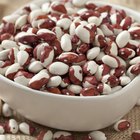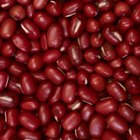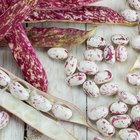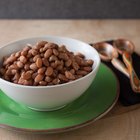
Design Pics/Design Pics/Getty Images
The most popular use for coffee beans is roasting them, grinding them and then filtering water through them to make coffee. Used this way, coffee beans yield little to no protein. The bean itself, however, does contain protein, whether you eat it “green” or after it is roasted.
Candy
Chocolate-covered coffee beans are probably the most common way to eat coffee beans whole. Covered in either milk chocolate or dark chocolate, each serving of about 28 beans contains 3 g of protein. In addition to protein, coffee also contain 3 g of fiber for each 28-bean serving.
Brewed Coffee
The roasting process makes a small percentage of the protein in coffee beans soluble in water. However, brewed coffee retains only 0.28 g of protein per cup. None of the fiber present in the original bean remains in the brewed coffee product.
Amino Acids
Amino acids are the building blocks of protein. The protein from coffee contains primarily three of the 22 amino acids: glutamic acid, glycine and aspartic acid. Additional trace amounts of threonine, isoleucine, leucine, lysine, cystine, phenylalanine, tyrosine, valine, arginine, histidine, alanine, proline and serine exist, which means that coffee beans contain at least a small amount of seven of the nine essential amino acids.
Caffeine
Unlike the other bean and seed protein sources, coffee contains caffeine. Each 28-bean serving of chocolate-covered coffee beans contain 336 mg of caffeine – several times the 95 mg of caffeine in a cup of brewed coffee. The caffeine content of coffee beans makes them a less-than-ideal source of protein. Consider the protein to be an unexpected bonus with your sweet treat rather than a legitimate source of protein to fulfill your daily needs.
Related Articles

Description & Characteristics of ...

How to Eat Espresso Beans

How to Dye Blond Hair With Coffee

Number of Calories in Dark ...
Keurig Coffee Nutrition

How to Descale a Gaggia
Difference Between French & Colombian ...

How to Cook Petai

How to Make Loose Tea in a Coffee Pot

The Nutritional Value of Anasazi Beans ...

How to Soak Adzuki Beans

How to Remove Mold From Coffee Beans

Which Country Produces the Most ...

How to Freeze Lentils

What Is the Nutrition for Cranberry ...

How to Remove Coffee Stains From Dry ...
Best Crock-Pot Pinto Beans Recipe

The Antioxidant Levels of Cacao

How to Cook Pinto Beans in a Crock Pot

What Is the Nutritional Value of Wheat?
References
Writer Bio
Chance Woods has been a personal trainer since 2002, specializing in fitness and nutrition. She holds a Bachelor of Science in dietetics.
Photo Credits
Design Pics/Design Pics/Getty Images